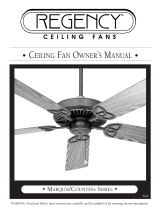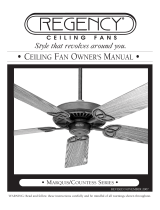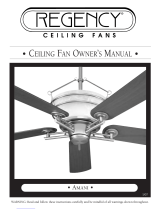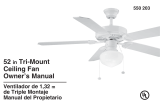Regency LX series User manual
- Category
- Household fans
- Type
- User manual
This manual is also suitable for

• LX SERIES •
•
CEILING FAN OWNER’S MANUAL
•
WARNING: Read and follow these instructions carefully and be mindful of all warnings shown throughout.
5/04

GENERAL INSTALLATION & OPERATION INSTRUCTIONS
IMPORTANT SAFEGUARDS:
1. To ensure the success of the installation, be sure to read the instructions and review the diagrams thoroughly
before beginning.
2. To avoid possible electric shock, be sure electricity is turned off at the main power box before wiring. All
electrical connections must be made in accordance with local codes, ordinances and/or the National Electric Code.
If you are unfamiliar with the methods of installing electrical wiring and products, secure the services of a qualified
and licensed electrician as well as someone who can check the strength of the supportive ceiling members and make
the proper installation(s) and connections.
3. Make sure that your installation site will not allow rotating fan blades to come in contact with any object. Blades
should be at least 7 feet from floor when fan is operating.
4. If possible, mount ceiling fan on a ceiling joist - the joist must be able to support the motion and weight of the
moving fan. If the fan will be mounted on a ceiling outlet box, an approved box UL listed as “suitable for fan
support” is required. The box and its supporting members must be able to support the moving weight of the fan
(at least 35lbs.). The box must not be able to twist or work loose. Installation on a concrete ceiling should be
performed by qualified personnel.
5. Blades should be attached after
motor housing is hung and in place. Fan motor housing should be kept in the carton
until ready to be installed to protect its finish. If you are installing more than one ceiling fan, make sure that you
do not mix fan blade sets, as each blade is part of a weighted set.
6. After making electrical connections, spliced conductors should be turned upward and pushed carefully up into
outlet box. The wires should be spread apart with the common conductor and the grounding conductor on one
side of the outlet box, and the “HOT” wires on the other side.
7. Electrical diagrams are for reference only. Light kits that are not packed with the fan must be UL listed and should
be installed per the light kit’s installation instructions.
8. After fan is completely installed, check to make sure that all connections are secure to prevent fan from falling
and/or causing damage or injury.
9. The fan can be made to work immediately after installation – the bearings are adequately charged with grease so
that, under normal conditions, further lubrication should not be necessary for the life of the fan.
10. The fan should be turned off and allowed to stop rotating before reversing fan direction.
11. When inserting bulbs, do not exceed the 300-watt maximum. The upper lighting fixture uses four 25-watt
bulbs, leaving the remaining 200-watts for the optional lower light kit.
1

Warnings:
• Disconnect power by removing fuse or turning off circuit breaker before installing the fan and/or optional
lighting. Support directly from building structure.
•To reduce the risk of fire, electric shock, or personal injury, mount to outlet box marked “acceptable for fan
support” and use mounting screws provided with the outlet box. Most outlet boxes commonly used for the support
of lighting fixtures are not acceptable for fan support and may need to be replaced. Consult a qualified electrician if
in doubt.
•To reduce the risk of fire, electrical shock, or personal injury, only use this fan with an appropriate speed control
device designed for use with ceiling fans, if you choose a wall control. DO NOT USE A SIMPLE INCANDESCENT
LIGHT DIMMER. Do not use this fan with any transformer type fan speed control device.
•To reduce the risk of personal injury, do not bend the blade arms when installing them, balancing the blades or
cleaning the fan. Do not insert any objects(s) between rotating fan blades.
NOTE: The important precautions, safeguards and instructions appearing in this manual are not meant to cover
all possible conditions and situations that may occur. It must be understood that common sense, caution and
carefulness are factors which cannot be built into this product. These factors must be supplied by the person(s)
installing, caring for, and operating the unit.
TOOLS AND MATERIALS REQUIRED
Thank you for choosing a Regency Ceiling Fan. You have chosen the best!
Your new ceiling fan has been designed to provide many years of service and enjoyment.
• Phillips screwdriver
• Blade screwdriver
• Wrench or pliers
• Wire cutter
• Stepladder
• Wiring supplies as required by
electrical code
2
IMPORTANT SAFETY PRECAUTIONS

1. Unpack your fan and check the contents. Do not discard the carton. If warranty replacement or repair is ever necessary,
the fan should be returned in original packing. Remove all parts and hardware. Do not lay motor housing on its side,
or the decorative housing may shift, be bent or damaged.
2. Examine all parts. You should have the following:
UNPACKING YOUR FAN
3
1. Mounting bracket
2. Ceiling canopy
3. Downrod/ball assembly
4. Decorative collar cover
5. Fan housing with motor (Remove rubber shipping supports around motor, if included on your fan. Save screws.)
6. Detachable switch housing with pull chain and reverse switches
7. Pull chains with fobs
8. Blade arms (5)
9. Fan blades (5) (Packed in separate box.)
10. Bracket hardware (wood screws, washers, wire nuts)
11. Blade arm to motor screws (10)
12. Blade arm to blade screws, w/washers (15)
13. Downrod pin and cotter pin
NOTE: Design of parts shown above may look slightly different for your specific model of fan.

PREPARATION:
Verify you have all parts before beginning the installation. Check foam insert closely for missing parts. Remove motor
from packing. To avoid damage to finish, assemble motor on soft padded surface or use the original foam inset in motor
box. Do not lay motor housing on its side as this could result in shifting of motor in decorative enclosure.
Caution: To avoid possible electrical shock, be sure
electricity is turned off at the main power box before wiring.
All wiring must be in accordance with National and Local
Electrical Codes and the ceiling fan must be grounded as a
precaution against possible electric shock.
1. Locate ceiling joist where fan is to be mounted, being sure
location agrees with the requirements in the minimum
clearance section of this guide. Wood joist must be sound
and of adequate size to support 35 lbs. (See Page 1, Items
3 and 4).
2. If not already present, mount a UL listed outlet box marked
“suitable for fan support” following the instructions
provided with the outlet box. The outlet box must be
able to support a minimum of 35 pounds.
3. Attach hanger bracket to outlet box using screws provided
with the outlet box.
PREPARATION
4
Ceiling Fan
Outlet Box
Hanger
Bracket
Flat Washer
Spring Washer
Washer Nut
Parts
identification
on
assembled
fan
INSTALLING THE MOUNTING BRACKET
Blade
Blade
Arm
Pull
Chain
Detachable
Switch
Housing
Collar
Cover
Downrod
Canopy
Motor
Housing
Pull
Chain
Uplights (on top
of fan motor
housing)

INSTALLING THE FAN
5
1. Carefully support fan body (motor) in its styrofoam packing with the mounting collar (where the wires come out)
facing upward.
2. Remove ball from downrod by loosening set screw in the side of the ball. Slide ball down and remove ball pin;
remove ball.
3. Feed the wires from top of fan through end of downrod you have chosen and set end of downrod into mounting
collar so the hole in the downrod lines up with the hole in the side of the mounting collar.
4. Insert downrod pin through holes in mounting collar and downrod; slip cotter pin through small hole in end of down-
rod pin to hold downrod in place.
5. Tighten security screws against downrod using a large flat blade screwdriver to ensure a tight fit against downrod.
Tighten nuts against mounting collar.
NOTE: Fan has 6 feet of hook-up wire in case
you are using a long extension downrod.
Wires can be cut so only 8 inches or so extend
beyond the top of the downrod to make the
electrical connections easier and safer.
6. Feed wires through collar cover and slide
collar cover down the downrod to top of
fan.
7. Feed wires through canopy and slide
canopy over downrod to lay on top of
collar cover. It will be attached to ceiling
later.
8. Feed wires through ball and slide ball
over downrod, past hole in the top end
of the downrod. Insert ball pin
(removed in step 2), slide ball up, and
tighten set screw to secure ball in place.
ATTACH DOWNROD:

1. Lift ball/downrod/fan into hanger bracket opening. NOTE: The tab opposite hanger bracket opening should fit in
slot on ball.
2. Make wire connections, (refer to section titled “Electrical Connections”).
3. Slide canopy up and fasten to hanger bracket with 4 screws provided.
6
INSTALLING THE FAN
HANG THE FAN
WARNING: To avoid damaging the blade arms and blades, do not install them onto fan until fan is fastened to ceiling.

ELECTRICAL CONNECTIONS: Be sure electricity is turned off at the main power box before wiring
ELECTRICAL CONNECTIONS
7
1. Four wires are connected to the fan.
Black – this is the “hot” power to run fan.
White – this is the “common” power to run fan and light.
Blue – this is the “hot” power for uplight and light kit.
Green – ground wire (on bracket or downrod).
2. If fan and light are to be connected to the same circuit, black and blue wires can both be connected to house circuit
black wire.
NOTE: The other end of the blue wire, (light circuit) is in the switch housing with a wire nut and label for light kit
attachment. The white wire (common for light kit) is also there.
*

8
BLADE ATTACHMENT
BLADE ATTACHMENT:
Fig. 2
1. Place fiber washer on screw. Insert this assembly through the blade and start the screw into the blade arm. Repeat
this procedure without tightening the screw until all 3 screws have been started into the blade arm (Fig. 1).
NOTE: Fans that have painted finishes may be packed with gaskets that can be used between the blade arm and blade to
help prevent a clicking noise that may develop if blade screws loosen over time.
2. Tighten each screw starting with center screw.
3 Fasten blade assembly to motor with provided screws and metal lockwashers (Fig. 2). Repeat procedure for remain-
ing blades. Make sure screws are TIGHT! Loose motor screws can contribute to unnecessary hum and wobble dur-
ing operation.
NOTE: Cordless power screw-
drivers are NOT recommended, as
they tend to strip the heads of the
screws and usually will not fully
compress the spring washers on the
motor screws. Use a large flat blade
screwdriver for final tightening to
fully compress the spring washers.
This will help ensure proper align-
ment of the blades and noise-free,
wobble-free running.
Fig. 1

9
INSTALLATION OF REMOVABLE SWITCH HOUSING
NOTE: Be sure the power is off before installing.
1. Loosen the 3 side screws on switch housing hub halfway.
2. If installing light kit, carefully remove light kit plug in bottom of switch housing. Attach light kit to switch housing
per instructions supplied with light kit. See “Electrical Connections” for hook-up of light kit.
3. Connect the plug and receptacle and make sure side buckle snaps in place.
4. Attach the switch housing to the switch housing hub. Align the side screws with keyhole slots on edge of switch
housing and tighten the side screws.
5. Attach pull chain fobs to ends of the switch’s pull chains – one for fan speed and one for uplight on/off.
6. Install candelabra base (E12) bulbs into sockets on top of fan housing for uplight. DO NOT EXCEED THE
RECOMMENDED WATTAGE FOR EACH BULB!
7. Turn the power on. Your Regency Ceiling Fan is now ready to enjoy!

10
OPERATION
Tu rn on the power and check operation of the fan. The fan is controlled by the use of the fan speed pull chain as follows:
one pull = high speed
two pulls = medium speed
three pulls = low speed
four pulls = off
For proper functions, ensure that the fan speed pull chain is pulled down fully and released each time. The uplight is turned
on/off by the other pull chain coming from the switch housing.
NOTE: Leave pull chain switch in “high speed” position when using optional wall control.
The slide switch on the side of the switch housing controls forward or reverse rotation. Make sure switch is not stuck
between forward and reverse positions.
IMPORTANT: To prevent damage or cause injury, be sure that fan is switched to off and blades have stopped moving
completely before attempting to change direction of rotation.
1. If fan will not start: Check main and branch circuit breakers and/or fuses. Check line wire connections to fan and switch
housing wiring. Make sure forward/reverse switch is set to one or the other position, not stuck in between.
2. If fan is noisy: Check and make sure that all screws in motor housing are snug (but not over tight). Check that the screws
securing blade brackets to the motor are tight. Check that wire connectors in switch housing are not rattling against each
other or the interior wall of the switch housing. Check that all glassware is finger tight and that bulb(s) are well held in the
sockets, if a light kit is used. Check that the canopy is firmly attached to hanging bracket and not vibrating against ceiling.
3. If fan wobbles: Check that all blades are firmly screwed into blade arms. Check that all blade arms are firmly secured to the
motor. Make sure that the light kit (if present) is firmly attached to switch housing and that all glassware and shades are fas-
tened properly. Wobble can also result from even the smallest deviations in distance from blade tip to blade tip - if measure-
ments from blade tip to blade tip are not equal, loosen screws connecting blade to bracket one at a time and adjust blade(s)
so that distances are equal. Interchanging adjacent blades may redistribute mass and result in smoother operation. Blade arms
can be bent slightly to restore same pitch to all blades if a blade is different than the other blades when viewed edge on.
TROUBLESHOOTING - IN CASE OF DIFFICULTY
Forward/Reverse Direction:
Forward is a counterclockwise rotation of the blades
when viewed from beneath the fan. This will create a
downward breeze that can be felt below the fan. This
is the normal direction for the fan to run when the
weather is warm.
Reverse (clockwise) will draw air up through the blades
and towards the ceiling, down the walls, and into the
living space during the cooler months.
WARM MONTHS
Forward (counterclockwise)
COOL MONTHS
Reverse (clockwise)

5/04 Regency Ceiling Fans
THANK YOU FOR PURCHASING A REGENCY CEILING FAN.
Write to us at:
Regency Ceiling Fans
P. O. Box 730
Fenton, MO 63026
Visit us on the Web at: www.regencyfan.com
Periodic cleaning of your new ceiling fan is about the only maintenance that is needed. Only use a soft brush or lint free
cloth to avoid scratching the finish. DO NOT use water when cleaning your ceiling fan. It could damage the motor or the
wood blades and/or create the possibility of electrical shock.
Periodically it may be necessary to re-tighten blade to blade arm screws or blade arm to motor screws to prevent
clicking or humming sound during operation. This is especially true in climates with broad temperature and
humidity ranges and in fans with painted or high gloss blades.
When dusting the blades, you must support the blade to prevent bending – no pressure should be applied to the blades.
CARE AND CLEANING
-
 1
1
-
 2
2
-
 3
3
-
 4
4
-
 5
5
-
 6
6
-
 7
7
-
 8
8
-
 9
9
-
 10
10
-
 11
11
-
 12
12
Regency LX series User manual
- Category
- Household fans
- Type
- User manual
- This manual is also suitable for
Ask a question and I''ll find the answer in the document
Finding information in a document is now easier with AI
Related papers
Other documents
-
 Regency Ceiling Fans Marquis Series User manual
Regency Ceiling Fans Marquis Series User manual
-
 Regency Ceiling Fans Akina Owner's manual
Regency Ceiling Fans Akina Owner's manual
-
 Regency Ceiling Fans Trend Owner's manual
Regency Ceiling Fans Trend Owner's manual
-
Design House 153791 Installation guide
-
AireRyder F0042 User manual
-
Hampton Bay 1000053064001 Operating instructions
-
Design House 152991 Installation guide
-
 Hampton Bay YG269-WH Installation guide
Hampton Bay YG269-WH Installation guide
-
Home Decorators Collection AC303-NI MH Installation guide
-
Home Decorators Collection AL499-WH Installation guide















